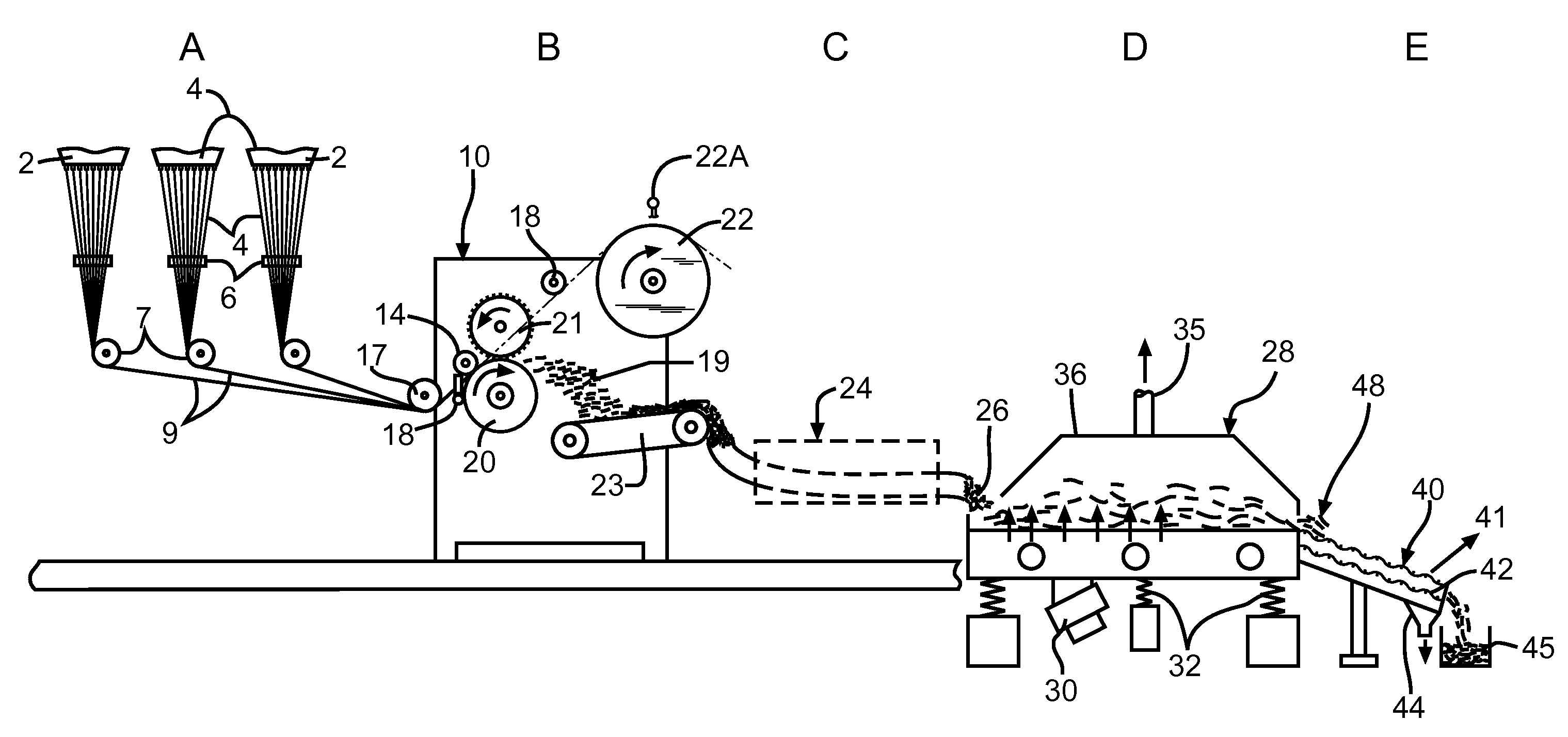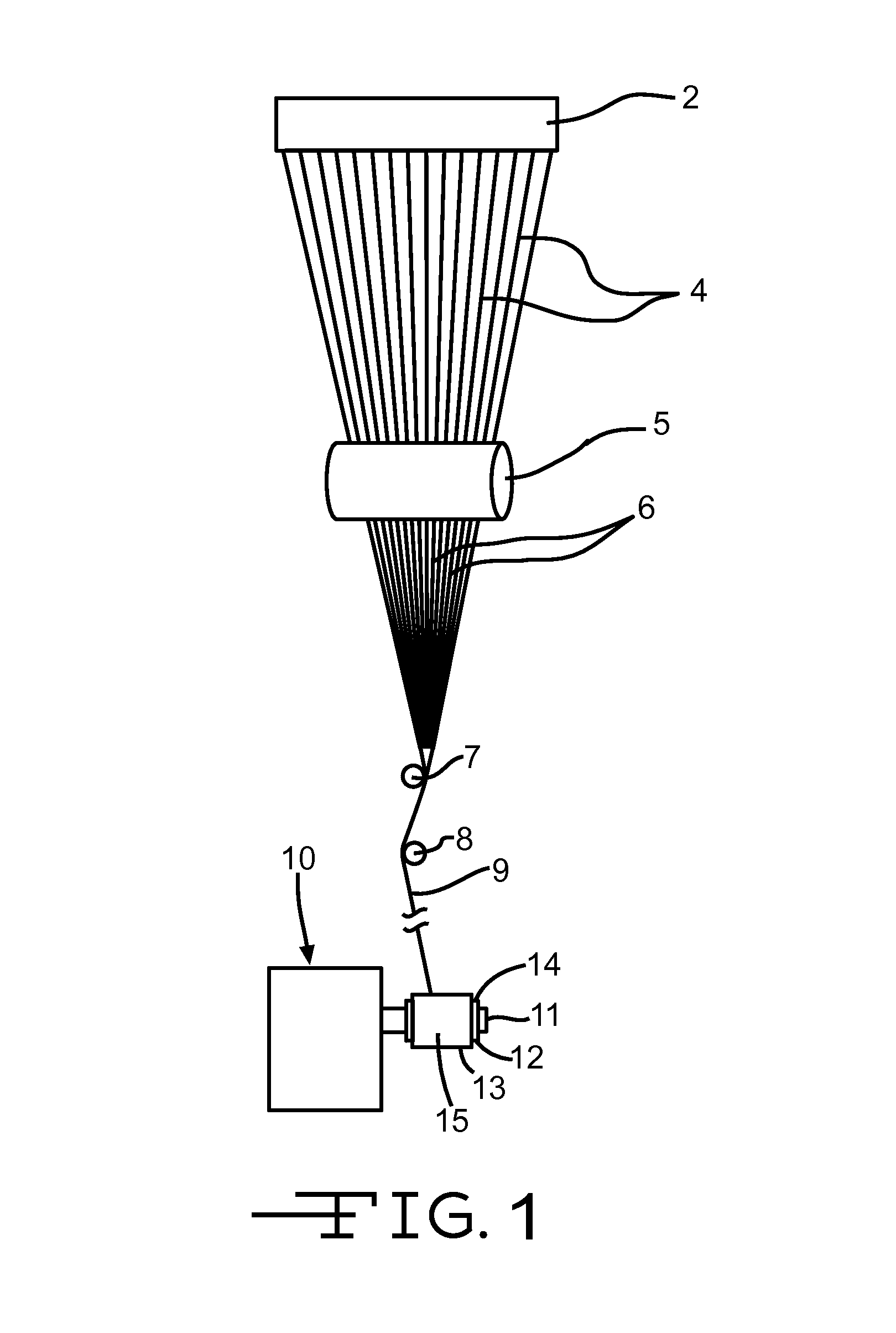Methods of making reactive fiber/flake prepregs and reactive prepregs
a fiber/flake prepreg and fiber/flake technology, applied in the field of making reactive fiber/flake prepregs and reactive prepregs, can solve the problems of unreactive or reactive reinforcements, and achieve the effect of preventing polymerization and preventing sticking
- Summary
- Abstract
- Description
- Claims
- Application Information
AI Technical Summary
Benefits of technology
Problems solved by technology
Method used
Image
Examples
example 1
[0091]This example uses one or more of nonwoven mat, scrim, chopped strand mat, or any kind of woven fabric, all made using reactive fibers having one or more S-A-X compounds chemically bonded to the surfaces of the fibers, such as glass fibers. In this example a woven fabric but made using dry direct wound rovings of reactive glass fibers, i.e. glass fibers having about 0.7 to about 3 wt. percent, based on the dry weight of the fibers, of a S-A-X compound,
[0092]chemically bonded to their surfaces and made by the process shown in FIG. 1. This woven fabric was coated with a molten mixture having a temperature of about 80° C. (within a range of about 65 to about 90° C.) and containing about 96-99 wt. percent of caprolactam monomer and about 1-4 wt. percent of the catalyst, magnesium bromide-caprolactam, using a coating process. The amount of coating mixture on the woven fabric was about 20-50 wt. percent based on the final weight of the prepreg. This prepreg was then cooled to and / or ...
example 2
[0097]Glass fibers with or without flakes in the form of either a reactive woven fabric or scrim or reactive non-woven mat or a combination of these were fed onto a separator sheet moving on the conveyor belt of the prepreg forming system. Several layers of fabric or mat were used to achieve a glass loading of >50%. The glass contained 1 to 3% by weight of triethoxypropylsilane isocyanate-capped caprolactam residue PI on the reinforcement surfaces bonded to the glass via the silane linkage. Next a mixture of molten caprolactam and sodium caprolactam catalyst (1-3% by weight with respect to caprolactam) having a temperature of about 80° C., within the desired range of about 65° C. and about 90° C., was spread onto the reactive glass fibrous material as it moved along, a separator sheet was fed onto the top of the monomer mixture and then this moving mass was moved through a plurality of opposed compacting rolls to force the monomer mixture into the reinforcing material and to wet out...
example 3
[0098]After non-reactive glass fiber fabric and nonwoven mat and glass veil mats, all being at a temperature below about 120° C., are fed onto a separator sheet on the moving belt, a molten mixture of caprolactam and a catalyst and PI for the anionic polymerization to form Nylon was spread onto this non-reactive fibrous mass and covered with a separator sheet, and this mass was run through a plurality of compacting rolls to force the mixture into the fibrous mass and wet out the glass fibers and this prepreg was cooled to below 120° C. This prepreg was capable of being molded and polymerized upon heating to form a reinforced Nylon composite.
[0099]The anionic polymerized Nylon (AP Nylon) prepregs provide a hitherto unforeseen option to manufacturers of composite parts. Instead of processing the AP Nylon composite using monomer / catalyst / PI mixtures, the manufacturers of composites only need purchase, or make, and use the solid prepregs of the present embodiments to produce composites,...
PUM
| Property | Measurement | Unit |
|---|---|---|
| Fraction | aaaaa | aaaaa |
| Fraction | aaaaa | aaaaa |
| Fraction | aaaaa | aaaaa |
Abstract
Description
Claims
Application Information
 Login to View More
Login to View More - R&D
- Intellectual Property
- Life Sciences
- Materials
- Tech Scout
- Unparalleled Data Quality
- Higher Quality Content
- 60% Fewer Hallucinations
Browse by: Latest US Patents, China's latest patents, Technical Efficacy Thesaurus, Application Domain, Technology Topic, Popular Technical Reports.
© 2025 PatSnap. All rights reserved.Legal|Privacy policy|Modern Slavery Act Transparency Statement|Sitemap|About US| Contact US: help@patsnap.com



